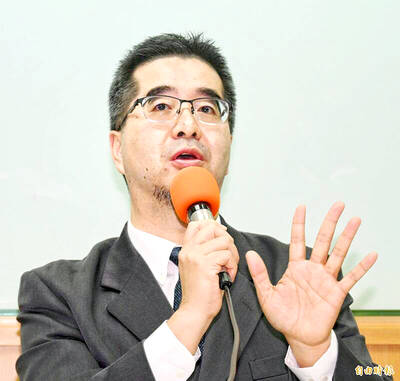Much to the delight of local preservationists, efforts to establish a second natural breeding ground for the endangered Formosan landlocked salmon have met success, Shei-Pa National Park Administration said.
Liao Lin-yen (廖林彥), director of the park’s Wuling Formosan Landlocked Salmon Conservation Center, said that after it released 250 Formosan landlocked salmon bred in captivity into the Luoyewei Stream (羅葉尾溪) and Sijielan Stream (司界蘭溪) last June, 28 salmon had been spawned.
SPAWNING GROUNDS
“We have found eight spawning grounds along the Luoyewei Stream and four spawning grounds in the Sijielan Stream,” he said. “A total of 28 fish have so far been spawned.”
The discovery indicates that captive-bred rare salmon can naturally breed after being released into the wild, Liao said, adding that the center has spent about 17 years to achieve this goal.
Encouraged by the results, Liao said, the park administration is scheduled to release up to 1,000 salmon parr in both streams on May 22 in hopes of establishing them as a second natural habitat for the Formosan landlocked salmon — a holdover from the last Ice Age and considered one of Taiwan’s national treasures — within five years.
TRADITIONAL HABITAT
Work by the conservation center has also boosted the number of Formosan landlocked salmon in the Cijiawan Creek (七家灣溪) — its traditional habitat — from slightly more than 200 in 1995 to more than 4,000 now.
The conservation center has not released captive-bred salmon parr in the river since 2006 and has instead launched a “take young salmon home” program, Liao said.
Under the project, Liao said, the center set up a “species bank” for the Formosan landlocked salmon and began releasing salmon fry into streams where the species had been found in the past.
DIFFICULTIES
Initially, the program achieved little success, Liao said.
The center released 1,500 salmon parr into three streams near the Cijiawan Creek four years ago, but most of them were washed away during typhoons before they could spawn.
A field survey found that larger volumes of water brought by typhoons as a result of global warming were having a negative impact on the species’ breeding, Liao said.
“We then decided to release salmon parr into other branches of the creek that are linked to deeper ponds and have more stable water flow,” Liao said, adding that this new approach had paid off.

The Coast Guard Administration (CGA) yesterday said it had deployed patrol vessels to expel a China Coast Guard ship and a Chinese fishing boat near Pratas Island (Dongsha Island, 東沙群島) in the South China Sea. The China Coast Guard vessel was 28 nautical miles (52km) northeast of Pratas at 6:15am on Thursday, approaching the island’s restricted waters, which extend 24 nautical miles from its shoreline, the CGA’s Dongsha-Nansha Branch said in a statement. The Tainan, a 2,000-tonne cutter, was deployed by the CGA to shadow the Chinese ship, which left the area at 2:39pm on Friday, the statement said. At 6:31pm on Friday,

The Chinese People’s Liberation Army Navy’s (PLAN) third aircraft carrier, the Fujian, would pose a steep challenge to Taiwan’s ability to defend itself against a full-scale invasion, a defense expert said yesterday. Institute of National Defense and Security Research analyst Chieh Chung (揭仲) made the comment hours after the PLAN confirmed the carrier recently passed through the Taiwan Strait to conduct “scientific research tests and training missions” in the South China Sea. China has two carriers in operation — the Liaoning and the Shandong — with the Fujian undergoing sea trials. Although the PLAN needs time to train the Fujian’s air wing and

Taiwanese celebrities Hank Chen (陳漢典) and Lulu Huang (黃路梓茵) announced yesterday that they are planning to marry. Huang announced and posted photos of their engagement to her social media pages yesterday morning, joking that the pair were not just doing marketing for a new show, but “really getting married.” “We’ve decided to spend all of our future happy and hilarious moments together,” she wrote. The announcement, which was later confirmed by the talent agency they share, appeared to come as a surprise even to those around them, with veteran TV host Jacky Wu (吳宗憲) saying he was “totally taken aback” by the news. Huang,

The American Institute in Taiwan (AIT) put Taiwan in danger, Ma Ying-jeou Foundation director Hsiao Hsu-tsen (蕭旭岑) said yesterday, hours after the de facto US embassy said that Beijing had misinterpreted World War II-era documents to isolate Taiwan. The AIT’s comments harmed the Republic of China’s (ROC) national interests and contradicted a part of the “six assurances” stipulating that the US would not change its official position on Taiwan’s sovereignty, Hsiao said. The “six assurances,” which were given by then-US president Ronald Reagan to Taiwan in 1982, say that Washington would not set a date for ending arm sales to Taiwan, consult